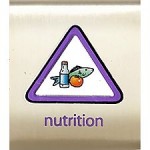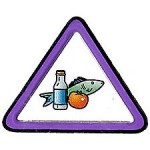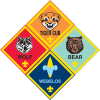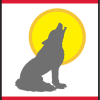Belt Loop
Complete these three requirements
- Make a poster of foods that are good for you. Share the poster with your den.
- Explain the difference between a fruit and a vegetable. Eat one of each.
- Help prepare and eat a healthy meal of foods that are included in a food pyramid.
(With your parent’s or adult partner’s permission, see http://www.mypyramid.gov.)
Academics Pin
Earn the Nutrition belt loop and complete five of the following requirements.
- Make a poster that shows different foods that are high in each of the vitamins. Using your poster, explain to your den or family the difference between a vitamin and a mineral and the importance of each for a healthy diet.
- Read the nutrition label from a packaged or canned food item. Learn about the importance of the nutrients listed. Explain what you learned to your den or family.
- Make a list of diseases that can be caused by a diet that is poor in nutrition.
- Talk with your school cafeteria manager about the role nutrition plays in the meals your school serves.
- With an adult, plan a balanced menu of breakfasts, lunches, and dinners for your family for a week.
- Make a list of healthy snack foods. Demonstrate how to prepare two healthy snacks.
- With an adult, go grocery shopping. Report to your den or other family members what you learned about choosing good foods to eat.
- Demonstrate how to safely prepare food for three meals.
- Demonstrate how to store leftover food to prevent spoilage or contamination.
- Help with a garden. Report to your den or family about what is growing in the garden and how you helped. Show a picture of or bring an item harvested from your garden.
- Visit a farm or ranch. Talk with the owner about how the farm or ranch produces food for families.
- Explain how physical exercise works with nutrition in helping people be fit and healthy. Demonstrate three examples of good physical activity.
Eating a balanced diet means eating foods that are good for you and that give your body the vitamins and other nutrients it needs to stay healthy.
Additional Information
Healthy Snacks
• Fresh fruits and vegetables
• Applesauce, fruit cups, fruit leather, or fruit salad
• Fruit juice popsicles or fruit smoothies
• Vegetables and dip
• Veggie pockets in whole wheat pitas
• English muffins
• Crackers or rice cakes and cheese
• Popcorn or pretzels
• Yogurt or low-fat pudding
• Nuts
What Do Vitamins Do?
Vitamin A helps keep your eyes healthy and helps you to have healthy skin.
Vitamin B (B1, B2, B6, and B12 plus others) helps your body work properly and gives you energy.
Vitamin C helps your body heal better and fights against infection.
Vitamin D helps strengthen your bones and teeth.
Vitamin E helps keep your skin and lungs healthy.
Which foods are rich in vitamin A? Eggs, milk, nectarines, cantaloupe, carrots, spinach
Which foods are rich in vitamin B? Whole grains (wheat, oats), fish/seafood, poultry/meats, eggs, dairy products (milk, yogurt), leafy green vegetables, beans and peas, citrus fruits (oranges, tangerines)
Which foods are rich in vitamin C? Cantaloupe, strawberries, tomatoes, broccoli, cabbage, citrus fruits
Which foods are rich in vitamin D? Milk, fish, eggs, dairy products (fortified with vitamin D)
Which foods are rich in vitamin E? Leafy green vegetables, sardines, eggs, nuts, whole grains
Which foods are rich in vitamin K? Broccoli, carrots, dairy products, eggs, spinach, tomatoes
Resources
Your local library can be an excellent source of information on nutrition, along with your local college extension service, the U.S. Department of Agriculture, and your local state department of Agriculture.
Resources About Nutrition
Eat Healthy, Feel Great, by William Sears,Martha Sears, and Christie Watts Kelly. Little, Brown Young Readers, 2002.
Good for You! Nutrition Book and Games, by Connie Liakos Evers. Disney Press, 2006.
How to Teach Nutrition to Kids, by Connie Liakos Evers. 24 Carrot Press, 2006.
The Race Against Junk Food, by Anthony Buono and Roy Nemerson. HCOM Inc., 1997.
Food Pyramid
Web site: http://www.mypyramid.gov/kids/index.html
Nutrition for Kids
Web site: http://nutritionforkids.com






